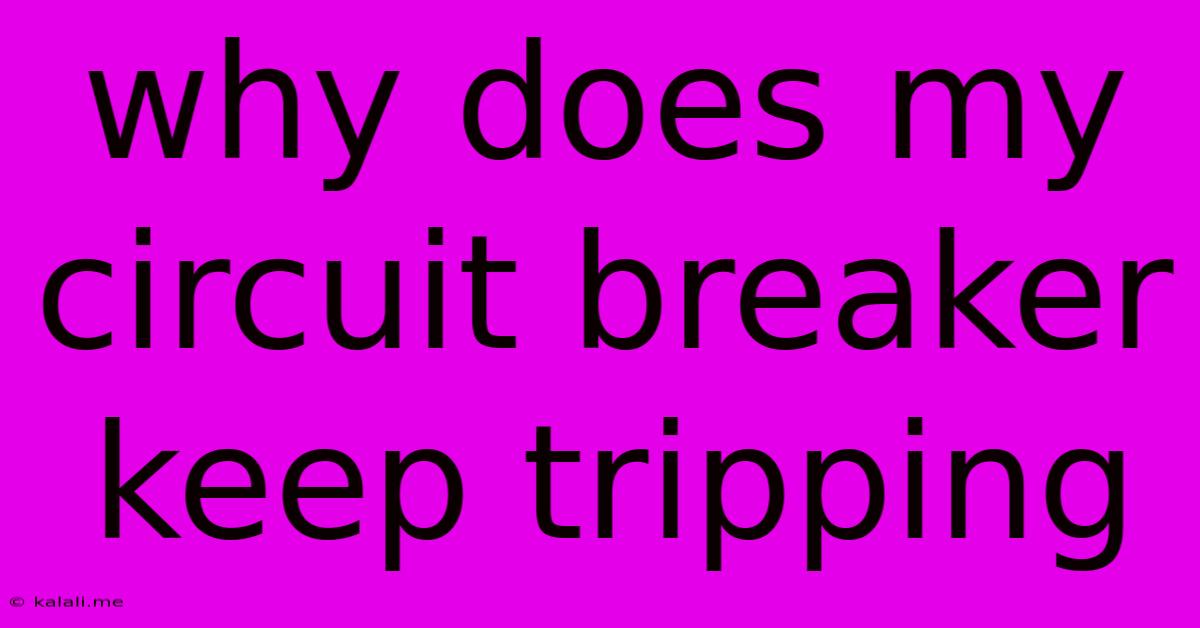Why Does My Circuit Breaker Keep Tripping
Kalali
May 25, 2025 · 3 min read

Table of Contents
Why Does My Circuit Breaker Keep Tripping? A Comprehensive Guide to Troubleshooting
A constantly tripping circuit breaker is more than just an annoyance; it's a sign that something's wrong with your electrical system. This guide will help you understand the common causes and provide practical steps to troubleshoot the problem. Ignoring a frequently tripping breaker can lead to electrical fires or damage to your appliances, so addressing the issue promptly is crucial.
Understanding Circuit Breakers
Before diving into troubleshooting, let's understand what a circuit breaker does. It's a safety device designed to protect your wiring and appliances from overloads and short circuits. When the current flowing through a circuit exceeds its rated capacity, the breaker trips, cutting off the power to prevent damage or fire.
Common Reasons for a Tripping Circuit Breaker:
There are several reasons why your circuit breaker might be tripping repeatedly. Here's a breakdown of the most common culprits:
1. Overloaded Circuit:
This is the most frequent cause. You've likely plugged too many appliances or devices into a single circuit, exceeding its amperage rating. High-wattage appliances like hair dryers, space heaters, and microwaves are particularly demanding. Consider the total wattage of all devices on a circuit and compare it to the circuit's capacity (usually 15 or 20 amps). Using a power strip can exacerbate this issue, so avoid daisy-chaining power strips.
2. Short Circuit:
A short circuit occurs when a live wire comes into contact with a neutral wire or ground, creating a low-resistance path for electricity to flow. This results in a surge of current, instantly tripping the breaker. Damaged cords, frayed wires, or faulty appliances are common culprits. Look for signs of damage on appliance cords and plugs, and check for any exposed wires in wall outlets or junction boxes.
3. Faulty Appliance:
A malfunctioning appliance can draw excessive current, leading to a tripped breaker. This could be due to internal wiring issues, a failing motor, or other internal component problems. Unplug the suspected appliance and try resetting the breaker. If it trips again, the appliance is likely the problem. Consider having it repaired or replaced by a qualified electrician.
4. Ground Fault:
A ground fault occurs when electricity leaks from the wiring to the ground, often due to moisture or damaged insulation. Ground Fault Circuit Interrupters (GFCIs) are designed to detect these faults and trip the breaker. This is common in bathrooms, kitchens, and outdoor outlets. If a GFCI keeps tripping, check for water leaks or damaged wiring near the outlet.
5. Loose Wiring:
Loose connections in wiring can create resistance and generate heat, potentially leading to a tripped breaker. This is more likely in older homes or areas with outdated wiring. Loose wiring requires professional attention; attempting to fix it yourself could be dangerous.
6. Power Surge:
Sudden surges in power can overwhelm a circuit, causing the breaker to trip. These surges can be caused by lightning strikes or problems with the power grid. Surge protectors can help mitigate the impact of power surges on your appliances and electronics.
Troubleshooting Steps:
- Identify the affected circuit: Determine which circuit is tripping by checking which lights or outlets are no longer working.
- Unplug appliances: Unplug as many appliances as possible from the affected circuit.
- Reset the breaker: Turn the breaker completely off, then back on.
- Gradually plug in appliances: Plug in appliances one at a time, noting if the breaker trips. This helps identify the faulty appliance.
- Check for loose wiring and damaged cords: Carefully inspect all cords and connections for damage or looseness.
- Look for water damage: Check for moisture or water leaks around outlets and appliances.
When to Call an Electrician:
If you've tried these steps and your circuit breaker continues to trip, or if you're uncomfortable working with electricity, it's best to call a qualified electrician. Electrical problems can be dangerous, and professional help ensures your safety and the proper repair of your electrical system. Ignoring persistent tripping breakers can lead to serious consequences, so addressing the issue promptly is key to maintaining a safe and functional home environment.
Latest Posts
Latest Posts
-
How Do You Change Skins In Batman Arkham City
May 25, 2025
-
Car Wont Turn Over No Clicking
May 25, 2025
-
How To Keep Binky From Falling Out
May 25, 2025
-
How To Cut Plywood By Hand
May 25, 2025
-
Can You Lay Concrete On Wet Ground
May 25, 2025
Related Post
Thank you for visiting our website which covers about Why Does My Circuit Breaker Keep Tripping . We hope the information provided has been useful to you. Feel free to contact us if you have any questions or need further assistance. See you next time and don't miss to bookmark.